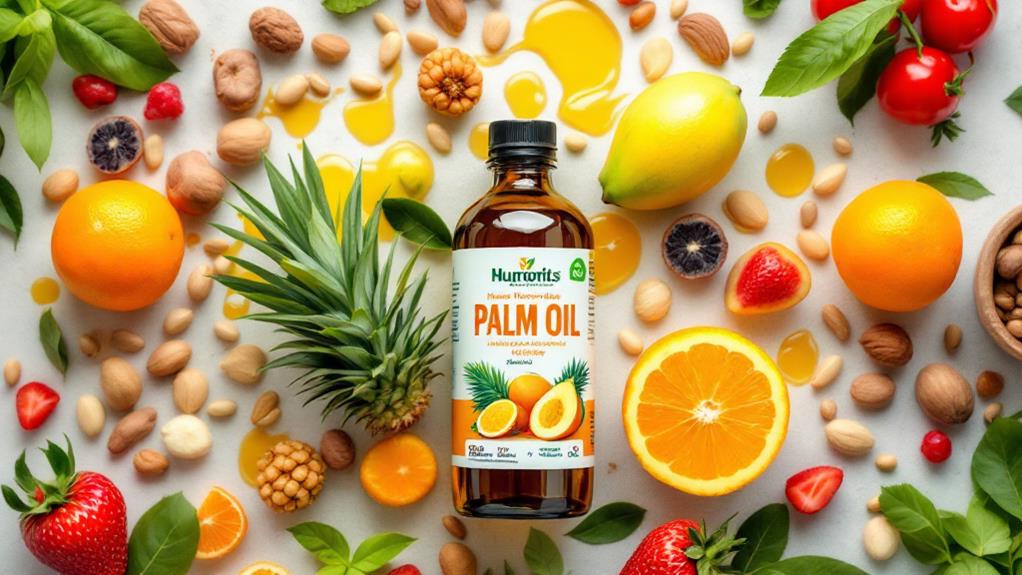The Uses and Health Benefits of Palm Oil: A Versatile and Controversial Ingredient

You're likely familiar with palm oil, which is deeply integrated into many everyday products. It offers potential health benefits when consumed moderately, like supporting heart and brain health due to its vitamin E and antioxidant content. Red palm oil, in particular, is rich in carotenoids and offers neuroprotective advantages. It's versatile in the kitchen thanks to its high smoke point and neutral flavor, making it ideal for frying and baking. However, palm oil production is controversial, involving environmental and ethical concerns. There's much to uncover about its impact and the ongoing push towards sustainability.
Understanding Palm Oil
Although palm oil may seem just like any other vegetable oil, it is unique in several ways that make it a staple in global agriculture and industry. Derived from the fruit of the oil palm tree, primarily in tropical areas like Indonesia and Malaysia, palm oil is incredibly efficient, yielding about 3.3 tons per hectare. This efficiency makes it more productive than other oils, reducing the environmental impact per unit of oil produced.
Palm oil is divided into crude palm oil and palm kernel oil. Crude palm oil, unrefined and nutrient-rich, retains its natural health benefits, including the presence of carotenoids and vitamin E. These nutrients in red palm oil can improve your vitamin A status and offer neuroprotective effects. However, it is crucial to acknowledge the high saturated fat content, which is around 50%. This can raise concerns about cardiovascular disease if consumed excessively.
On the other hand, palm kernel oil, derived from the seed, contains even more saturated fats. While palm oil provides health benefits, moderation is key to avoid negative impacts on heart health. Balancing its consumption can help you enjoy its nutritional advantages without adverse effects.
Nutritional Profile
To fully appreciate palm oil's role in your diet, it's crucial to reflect on its nutritional profile. One tablespoon of palm oil packs about 120 calories and 14 grams of fat. The fat composition is roughly 50% saturated fat, 40% monounsaturated fat, and 10% polyunsaturated fat. This high saturated fat content can increase LDL cholesterol levels, which may affect your heart health negatively if consumed in large amounts. Moderation is key to balancing its effects.
Palm oil is a notable source of vitamin E, offering 2.16 mg per tablespoon, which is 14% of your recommended daily allowance. Refined palm oil contains tocotrienols, a form of vitamin E with potential neuroprotective benefits, possibly aiding brain health. Red palm oil, on the other hand, is richer in both vitamin E and carotenoids like beta carotene, which your body can convert into vitamin A. This lively oil is also packed with antioxidants, making it a valuable supplement to a range of dishes while supporting general health.
Health Benefits

Palm oil offers several potential health benefits when consumed in moderation. Despite its high saturated fats content, which can raise LDL cholesterol if overconsumed, it still holds some promising properties. Red palm oil, in particular, is rich in vitamin E and carotenoids. These compounds are not only significant for those with vitamin A deficiency but also contribute to the antioxidant properties of the oil. Antioxidants play an important role in supporting heart health by combating oxidative stress that can lead to cardiovascular issues.
The tocotrienols, a form of vitamin E found in palm oil, deserve special mention. They may offer neuroprotective effects, potentially slowing the progression of dementia and reducing stroke risk. This makes palm oil an intriguing supplement to a diet focused on long-term brain health. However, it is critical to balance its consumption, keeping in mind its calorie and fat content, which can contribute to total energy intake without providing other macronutrients like protein or fiber.
Incorporating palm oil, especially red palm oil, can support heart and brain health, but moderation is key to maximizing its health benefits while minimizing potential risks.
Culinary Applications
While it's crucial to enjoy palm oil in moderation for its health benefits, you might find its culinary adaptability just as compelling. As a cooking oil, palm oil's high smoke point of about 450°F (232°C) makes it ideal for frying and baking. This means you can use it without worrying about it breaking down under high heat. In baking, palm oil acts as a natural preservative, enhancing the texture and extending the shelf life of numerous processed foods like baked goods and snacks.
Palm oil's role doesn't end there. With nearly 50% of packaged products in supermarkets containing palm oil, its versatility is clear. Regardless of if it's chocolate, pizza, or ice cream, palm oil's neutral flavor and color make refined palm oil a popular choice in food manufacturing. This allows it to blend seamlessly into a broad range of edible items without altering their taste or appearance.
For a burst of color and flavor, red palm oil, rich in antioxidants and carotenoids, is perfect for traditional dishes, especially in West African cuisine. With these diverse culinary applications, palm oil proves to be an irreplaceable ingredient in kitchens worldwide.
Environmental Impact

Despite its widespread use in kitchens and food products, the environmental impact of palm oil production is significant and troubling. Palm oil plantations are a leading cause of deforestation, with nearly half of the land used for these plantations having been forested as recently as 1990. This deforestation results in severe habitat destruction, threatening biodiversity and leading to the loss of homes for endangered species like the Bornean orangutan. The land clearing methods often involve burning, which contributes to greenhouse gas emissions by releasing stored carbon from trees and soil into the atmosphere.
In Southeast Asia, where much of the world's palm oil is produced, the expansion of these plantations poses a dire threat to the region's rich biodiversity. Sustainable palm oil initiatives, such as those promoted by the Roundtable on Sustainable Palm Oil (RSPO), aim to address these issues by encouraging better land use practices that minimize environmental damage. However, the effectiveness of these initiatives varies widely, with some producers not fully adhering to the standards. While the industry continues to face ethical concerns, the push for sustainable palm oil represents a step toward reducing its total environmental impact.
Ethical Concerns
Frequently overlooked in discussions about palm oil is the industry's troubling ethical landscape. The palm oil industry faces significant ethical concerns, especially regarding human rights abuses. Reports of child labor and forced labor on plantations highlight a blatant disregard for the rights and welfare of vulnerable populations. These practices not only exploit individuals but also tarnish the industry's image.
Deforestation driven by palm oil production poses severe threats to biodiversity, challenging our sense of environmental stewardship. The destruction of habitats for endangered species like orangutans and Sumatran rhinos raises moral questions that demand your attention.
Moreover, land-grabbing by corporations displaces local communities, stripping them of their traditional lands and resulting in social injustice. These actions destabilize the economic foundations of indigenous populations, adding another layer to the industry's ethical challenges.
Transparency and accountability issues in palm oil supply chains fuel corruption, further exacerbating human rights abuses. While initiatives like the Roundtable on Sustainable Palm Oil (RSPO) aim to promote sustainable palm oil practices, ensuring compliance across the sector remains a challenge. It's crucial to recognize these ethical concerns and advocate for more responsible and transparent practices within the industry.
Regulatory Aspects

With regard to the regulatory aspects of palm oil, diverse bodies are tasked with ensuring its production adheres to safety and quality standards. Regulatory bodies play an essential role in monitoring palm oil production to guarantee food safety compliance. They assess both palm oil and its tocotrienol-rich fractions for safety. Product labeling requirements, including ingredient lists, differ across regions. Some countries mandate clear identification of palm oil, ensuring transparency for consumers concerned about saturated fat intake and health effects.
The U.S. Department of Agriculture contributes to ongoing research, investigating the health effects of palm oil consumption. This research is significant as public health recommendations evolve based on emerging findings. Concerns about saturated fat intake remain, yet the exploration of potential health-promoting effects continues.
In the UK, efforts toward sustainable palm oil are notable. By 2019, 70% of palm oil imports were sustainable, following a governmental commitment. Sustainable palm oil production aims to mitigate environmental impact while addressing health concerns. As ongoing research explores the long-term effects of palm oil consumption, regulatory bodies adapt and update guidelines to balance food safety, public health, and environmental sustainability.
Types of Palm Oil
When exploring the different types of palm oil, you'll primarily encounter two main varieties: crude palm oil and palm kernel oil. Crude palm oil is extracted from the fleshy fruit of the Elaeis guineensis tree. Known for its rich reddish hue, it contains antioxidants like vitamin E and carotenoids. These antioxidants not only give it color but also contribute to its health benefits. Red palm oil, a less processed version of crude palm oil, retains more phytonutrients and is often used in traditional cooking, offering a unique flavor and nutritional profile.
On the other hand, palm kernel oil comes from the seed and boasts a high saturated fat content of about 85%. It's often used in non-food products such as soaps and cosmetics because of its stability and emollient properties. While it shares the name, its nutritional profile markedly differs from crude and red palm oils.
Refined palm oil, derived from crude palm oil, undergoes processing to remove impurities. This results in a neutral flavor and a higher smoke point, making it versatile among vegetable oils. However, refining can strip away many beneficial compounds, reducing its antioxidant content.
Sustainable Alternatives

As we move from understanding the different types of palm oil, it's vital to reflect on how our choices impact the environment. Sustainable palm oil initiatives, like the Roundtable on Sustainable Palm Oil (RSPO), encourage environmentally friendly practices, aiming to reduce deforestation and support local communities. By choosing RSPO-certified products, you're endorsing sustainable practices that markedly lower greenhouse gas emissions—by up to 60% compared to conventional methods. This not only helps the planet but also strengthens community livelihoods.
Exploring alternatives to palm oil, such as olive oil, canola oil, and sunflower oil, offers different flavors and health benefits. However, these often require more land, which can increase their ecological footprint and cause other environmental issues. Hence, it's important to weigh the impact of these alternatives carefully.
Consider these options to make a positive change:
- Opt for RSPO-certified products to support sustainable palm oil.
- Explore local vegetable oil options to minimize ecological footprints.
- Choose oils that align with sustainable practices to reduce deforestation.
- Support smallholder farms to bolster community livelihoods.
- Be mindful of land use when selecting alternatives to palm oil.




